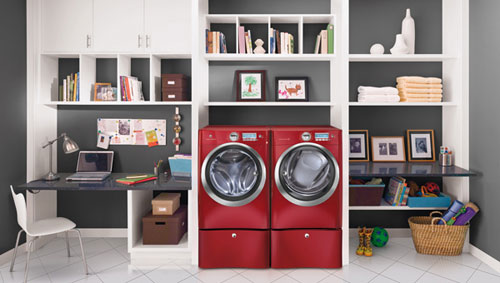Appliances for the Home: Sustainable Choices that Meet Accessibility and Lifestyle Needs
LAUNDRY APPLIANCES
 |
Large capacity and fast washer and dryer have a drawer for storing detergents. Photo: Electrolux Home Products, Inc. |
Â
Calling laundry "the American housekeeper's hardest problem," Catherine Beecher, advocate of bringing rationalization and dignity to housework, saw the advent of the world's first patented washing machine in 1846 but did not live to see the first electric clothes washer introduced about 1900. Her graphic descriptions of the staggering amounts of time and labor it took to wash just one load that used 50 gallons of water and caustic soaps are scarcely believable in light of today's washers and dryers.
What took hours of work can now be accomplished in a mere 18 minutes to wash and 18 minutes to dry in the fastest and largest ENERGY STAR rated machines presently on the market. With 4.7 cu. ft. capacity that can wash 23 lbs of laundry, these particular washers are 83 percent more energy efficient and use 56 percent less water than federal standards. Gas and electric dryers have an 8.0 cu. ft. capacity and the industry's largest moisture sensor that ensures even drying and prevents damage and overheating of clothing. In addition, three 1,800 watt heater elements provide temperature control over a range of settings.
Other innovative features can include:
- Steam dryer that removes wrinkles and freshens clothes.
- Balance system, which keeps over-sized loads, balanced for smooth and quiet vibration-free operation.
- Tumble system that employs a third vane to separate, lift and redistribute clothes while drying.
- Fade-to-black touch screen control panel offers several wash and dry cycle options plus settings such as ‘delay start' and ‘add steam option.'
- Sanitized rinse cycle, certified by NSF®.
- Pedestal drawers below washer and dryer for storing detergents.
- A large door opening for easy access.
- Drying technology that tumbles clothes in two directions for decreased tangling, more even drying and fewer wrinkles.
- Reversible doors that are easily changeable for users' convenience
DESIGN AND AESTHETICS
Since Europe is often considered about two years ahead of the curve in appliance design, U.S. manufacturers do well to keep an eye on the latest trends. Built-in kitchens and office-style curvilinear kitchen layouts were first seen in Europe, as were made-to-measure ranges in shapes that echo partners' desks and perfect ovals. But the U.S. as the home of mass production approaches appliance design with pragmatism. Manufacturers mostly reference European forms - but are taking a serious look at the colors, finishes and materials seen in Europe. The saturated hot red, Mediterranean blue and turquoise sky color options on some new washers and dryers echo recent European models - as does stainless steel, which was once the province of premium-priced European brands. New U.S. models have improved stainless steel coatings, which minimize complaints about fingerprints.
There was speculation about the next wave of finishes at the 2009 Eurocucina show in Milan where some appliances had mirror-like finishes. Since it takes approximately one year to add a new finish - but far longer to change technologies - it is conceivable that design professionals may soon be presented with additional choices to the predominant offerings of black, white and stainless.Â
Some new design features are driven by consumer demand, such as the pedestal drawer in the base of some washers and dryers. Others are the result of new digital technology, for example, the smooth uncluttered look generated by touch screen panels. But the most noticeable change in recent years is attention to designing appliances as a family whose members unmistakably belong to each other.
CONCLUSION
Driven by the need for sustainability and supporting today's consumers, appliances are different from those of just ten years ago. They can exceed federal energy standards by as much as 80 percent, at the same time as offering support and accessibility for people of all ages and lifestyles. While design professionals evaluate innovations and note color finishes, they should also be aware that appliances are a player in the drive for sustainability.
Â
|









